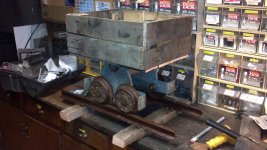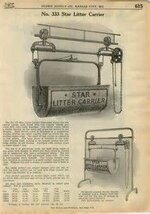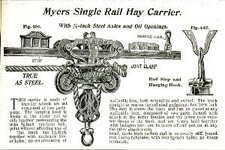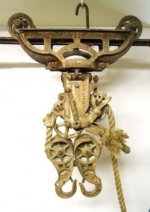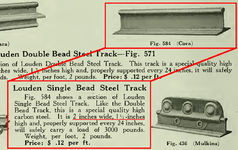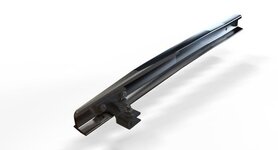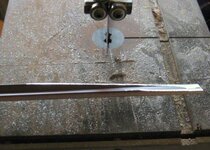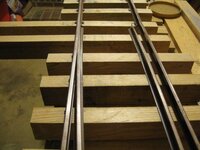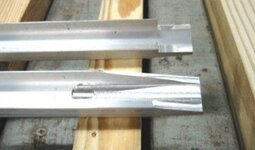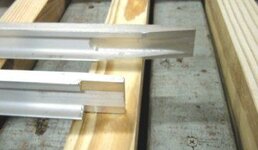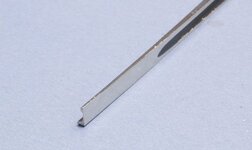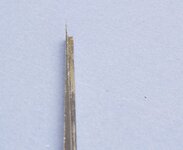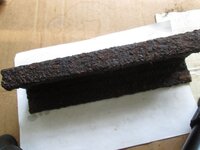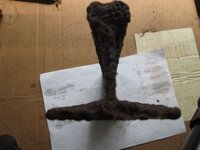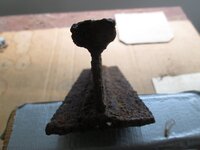Alright. I know what I really, really want this to be. I also know it's probably just junk, and either way my wife is going to be really mad when she finds out I brought this home.
It's the last thing I found before my detector stopped functioning, and the only thing I got to dig this year.
Top down first. Measure almost exactly two feet long, but could be broken:
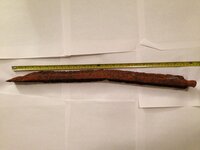
Bottom edge, which is wider than the top edge. Note it has been bent to one side a bit somehow:
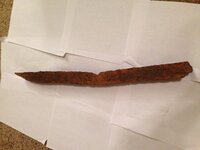
From the top down, the bottom edge measures just about 1.75 inches wide:
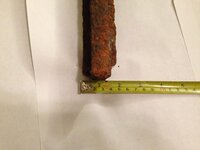
From top to bottom, it measures almost exactly two inches tall:
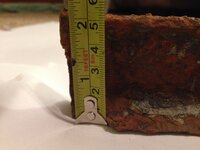
Laying on its side:
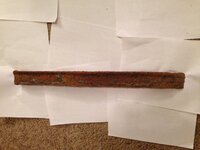
I have a feeling the view of the cross-section will imply function:
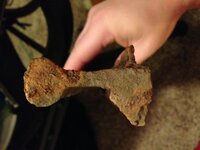
Finally, note that at the tapered end of the object, on the widest edge (the "side"), there is a groove that gradually tapers off and terminates such that it almost looks like the impression that a double-edged sword or the tip of a rocket would make:
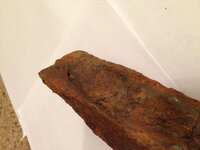
Background info if you desire:
The immediate vicinity where this was dug is in a farm field, near a fenceline. Finds date absolutely no earlier than 1873, and rarely later than 1945. The vast majority date between 1893 and 1908. This area was once a coal mining camp. The location where this object was dug was somewhere between 100 feet and 1/8th of a mile from a now long-gong section of the C.R.I.P. railroad. It was less than 1/8th of a mile from the shaft entrances for two bituminous coal mines, which had several miles of underground track. Prior to 1893, the area would have been unoccupied timber/wilderness. Between 1893 to 1908 the area was a coal mining camp. From 1908 to 1925 the area would have been vacant. From 1925 to present, the area would have been agricultural farmland. Accordingly this object is with great confidence either related to farming or coal mining.
Thanks for any help, you all know I appreciate it very much.
-mcl
It's the last thing I found before my detector stopped functioning, and the only thing I got to dig this year.
Top down first. Measure almost exactly two feet long, but could be broken:

Bottom edge, which is wider than the top edge. Note it has been bent to one side a bit somehow:

From the top down, the bottom edge measures just about 1.75 inches wide:

From top to bottom, it measures almost exactly two inches tall:

Laying on its side:

I have a feeling the view of the cross-section will imply function:

Finally, note that at the tapered end of the object, on the widest edge (the "side"), there is a groove that gradually tapers off and terminates such that it almost looks like the impression that a double-edged sword or the tip of a rocket would make:

Background info if you desire:
The immediate vicinity where this was dug is in a farm field, near a fenceline. Finds date absolutely no earlier than 1873, and rarely later than 1945. The vast majority date between 1893 and 1908. This area was once a coal mining camp. The location where this object was dug was somewhere between 100 feet and 1/8th of a mile from a now long-gong section of the C.R.I.P. railroad. It was less than 1/8th of a mile from the shaft entrances for two bituminous coal mines, which had several miles of underground track. Prior to 1893, the area would have been unoccupied timber/wilderness. Between 1893 to 1908 the area was a coal mining camp. From 1908 to 1925 the area would have been vacant. From 1925 to present, the area would have been agricultural farmland. Accordingly this object is with great confidence either related to farming or coal mining.
Thanks for any help, you all know I appreciate it very much.
-mcl



